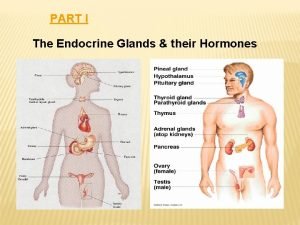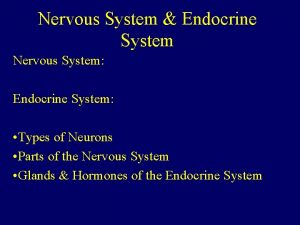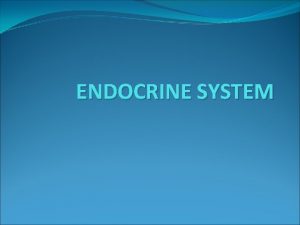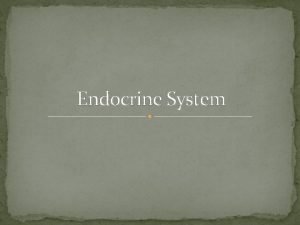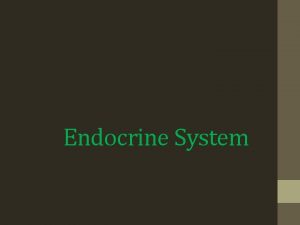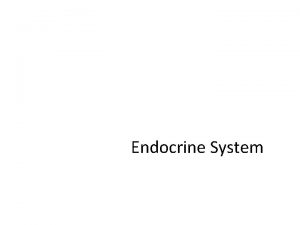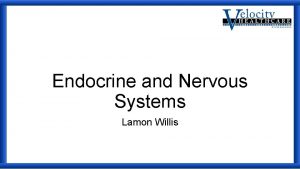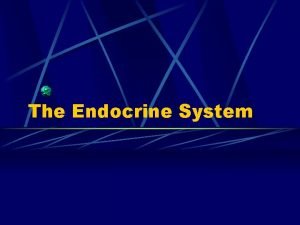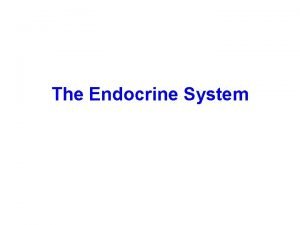Anatomy of the Nervous System Nervous and Endocrine
















- Slides: 16

Anatomy of the Nervous System

Nervous and Endocrine Systems work together to maintain homeostasis • • Nervous System Electrical signals FAST – milliseconds Short activity duration • Specific! • Endocrine System • Chemical signals – Hormones • Slow– sec. to hours • Longer activity duration • Travels through blood stream – not specific!

Functioning of the NS • Nerve impulses travel in 2 directions • Each direction uses a different set of nerves – Motor Nerves – Efferent (descending) • Take info AWAY from brain – Sensory Nerves – Afferent (ascending) • Take info TO the brain • The integrative function analyzes the sensory data and produces a response.

Nervous Tissue • Neurons (nerve cells) – Cell Body – Dendrites – Axon • Myelinated vs. Unmyelinated Saltatory impulses

Nervous Tissue (cont. ) • Neuroglial Cells (“nerve glue”) – Hold the structure of the nervous system together.

4 types of Neuroglial Cells • Microglial – • Small, phagocytic cells - go to injury/clean and engulf debris • Astrocytes – • stars – hold neurons together. Form bridges between neurons and capillaries.

Neuroglial Cells continued. . • Oligodendroglial – produce myelin sheath (protection) over neurons in CNS • Ependymal – line cavities, lubricates and protects. Produces and moves cerebrospinal fluid

A detailed look at the structure of a neuron… Motor Neuron

And a sensory neuron…

• What is the importance of the myelin sheath? • What are nodes of Ranvier?

Homework for WEDNESDAY • Read 237 -244 in your book • Do concept check questions on page 237! • We may have a short reading quiz tomorrow to check in!!!

Nerve Impulses • Axon membrane is POLARIZED when not active (at rest). – Potassium ions inside axon – Sodium ions outside axon – Negative organic ions inside

• Action potential = nerve impulse – Change in polarity flows down the axon’s membrane. – Depolarization – Na ions move into axon – Repolarization – K ions move out of axon

How does the info pass from one neuron to another? ? ? • Through the SYNAPSE – Gap between one neuron’s axon (synaptic knob) and another’s dendrite – This gap is called the SYNAPTIC CLEFT • Neurotransmitters (like acetylcholine and norepinephrine) pass the impulse from one neuron to the next

Neurological Disorders • Neurotransmitter imbalances – Huntington’s disease – nervous system degeneration (GABA dysfunction in brain) – Parkinson’s Disease – dopamine deficiency, tremors, unblinking expression – Alzheimer’s Disease – loss of neurons that use ACh

Reflex Arc • Unconscious motor response to a sensory stimulus. • Stimulation of sensory receptors evokes APs that are conducted into spinal cord. – Synapses with association neuron, which synapses with somatic motor neuron. • Conducts impulses to muscle and stimulates a reflex contraction. – Brain is not directly involved. Figure 8 -28
 Endocrine system and nervous system
Endocrine system and nervous system Endocrine system and nervous system
Endocrine system and nervous system General mechanism of hormone action
General mechanism of hormone action Sympathetic nervous system
Sympathetic nervous system Comparison of endocrine and nervous system
Comparison of endocrine and nervous system Are endocrine glands ductless
Are endocrine glands ductless Label the different types of neuronal pools in the figure.
Label the different types of neuronal pools in the figure. Fundamentals of the nervous system and nervous tissue
Fundamentals of the nervous system and nervous tissue Neuronal processes
Neuronal processes Endocrine system and reproductive system
Endocrine system and reproductive system Endocrine anatomy
Endocrine anatomy Lymphatic system vs endocrine system
Lymphatic system vs endocrine system Calcitonin and pth are antagonistic hormones
Calcitonin and pth are antagonistic hormones Nontropic hormones
Nontropic hormones Nervous system and digestive system
Nervous system and digestive system Chapter 16 matching questions 1-5
Chapter 16 matching questions 1-5 Adenohypophysis
Adenohypophysis
















